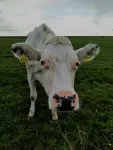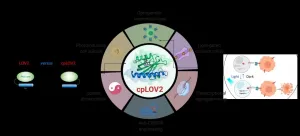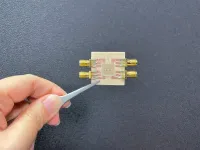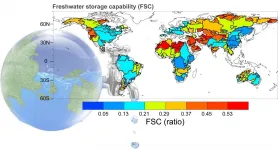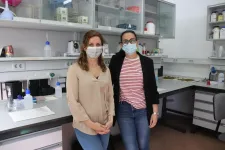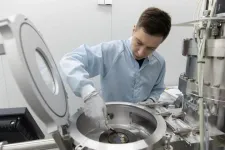(Press-News.org) Combining natural salt marsh habitats with conventional dikes may provide a more sustainable and cost-effective alternative for fully engineered flood protection. Researchers of the University of Groningen (UG) and the Royal Netherlands Institute for Sea Research (NIOZ) studied how salt marsh nature management can be optimized for coastal defence purposes. They found that grazing by both cattle and small herbivores such as geese and hare and artificial mowing can reduce salt marsh erosion, therefore contributing to nature-based coastal defence.
People around the world live in coastal areas that are prone to flooding. Dikes provide traditional flood protection for coastal defence purposes. In addition, salt marshes bordering these traditional barriers may strongly contribute to coastal protection by reducing wave forces on dikes.
Cost-effective
Hence, combining natural salt marsh habitats with conventional dikes may provide a more sustainable and cost-effective alternative for fully engineered flood protection. However, to safeguard this nature-based coastal defence, long-term salt marsh width and stability needs to be assured.
Researchers of the UG and NIOZ, therefore, studied how salt marsh nature management can be optimized for coastal defence purposes. They found that grazing by both cattle and small herbivores such as geese and hare and artificial mowing can reduce salt marsh erosion, therefore contributing to nature-based coastal defence. The results of this study have been published in the Journal of Applied Ecology.
Soil erosion
For this study, 78 soil samples were collected at different sites on the salt marsh of Schiermonnikoog, a barrier island in the Dutch Wadden Sea. At these locations, long-term exclosures were present to exclude grazing by either cows or smaller herbivores such as hare and geese.
Samples from grazed areas were compared with samples from the exclosures and artificially mowed sites. Soil cores were transported to the lab and exposed to artificial waves in controlled tanks. Researchers then measured soil erosion for a total of 38 hours.
Erosion resistance
The main author of the paper, Beatriz Marin-Diaz, explains: 'The sandiest cores eroded most heavily, whereas soils with more clay were more erosion resistant. Cow grazing enhanced this erosion resistance by compacting the soil by trampling. Surprisingly, small herbivores contributed to less erosion by changing the vegetation to plants with high root densities that bind the soil together.' In addition, the researchers found that artificial mowing also contributed to erosion resistance by excluding burying animals from the soil that destabilize the sediment.
Coastal protection
Overall, grazing and artificial mowing can reduce the erosion of fine?grained soils, making salt marshes more resilient to erosion. However, soil compaction by cattle simultaneously lowers the elevation of a marsh. This may impair their ability to keep up with sea-level rise.
Hence, to effectively manage salt marshes for coastal protection, the study recommends moderate or rotational livestock grazing, avoiding high-intensity grazing in sediment?poor systems sensitive to sea?level rise as well as investigating measures to preserve small grazers. This way, salt marshes can be managed effectively to enhance their coastal protection function.
INFORMATION:
Reference: Beatriz Marin-Diaz, Laura L. Govers, Daphne van der Wal, Han Olff and Tjeerd J. Bouma: How grazing management can maximize erosion resistance of salt marshes. Journal of Applied Ecology, first online 20 April 2021.
Recently, Prof. WANG Junfeng from the High Magnetic Field Laboratory of the Hefei Institutes of Physical Science (HFIPS), together with international scholars, developed a novel circular permutated light-oxygen-voltage 2 (LOV2) to expand the repertoire of genetically encoded photoswitches, which will accelerate the design of novel optogenetic devices. The result was published in Nature Chemical Biology.
LOV2 domain is a blue light-sensitive photoswitch. In a typical LOV2-based optogenetic device, an effector domain is fused after the C-terminal Jα helix of LOV2, intending to cage the effector via steric hindrance in the dark. On photostimulation, light-triggered unfolding of the Jα helix exposes the effector domain to restore its function. Crafting a LOV2-based ...
With the rise of the digital age, the amount of WiFi sources to transmit information wirelessly between devices has grown exponentially. This results in the widespread use of the 2.4GHz radio frequency that WiFi uses, with excess signals available to be tapped for alternative uses.
To harness this under-utilised source of energy, a research team from the National University of Singapore (NUS) and Japan's Tohoku University (TU) has developed a technology that uses tiny smart devices known as spin-torque oscillators (STOs) to harvest and convert wireless radio frequencies into energy ...
A new study may have uncovered why wall lizards have become the most successful reptile in the Mediterranean region. The results reveal how drastic changes in sea levels and climate 6 million years ago affected species formation in the area. The researchers believe they can now explain why the lizards became so diverse and widespread, something that has puzzled biologists since the 19th century. The study is published in Nature Communications.
The evolution of wall lizards offers clues on how major events in the Mediterranean climate and geology millions of years ago affected how species formed or became extinct, and also paved the way for biodiversity.
Wall lizards date back around 20 million years. However, ...
A University of Surrey project has revealed innovative methods that could dramatically improve the performance of future electrical vehicles (e-vehicles).
As part of the European Union's STEVE* project, Surrey has developed several pioneering approaches to torque vectoring in electric vehicles.
In e-vehicles with multiple motors, it is possible to deliver different amounts of drive power to each wheel. This benefits the vehicles' power consumption, safety and driveability. The process of calculating and optimising the precise amount of power needed while the vehicle ...
To support growing human and animal life, freshwater sources must continuously supply water. Freshwater from lakes, rivers, and underground is mainly recharged by rainfall. Ground reservoirs can store rainwater over time, depending on that location's storage capability. However, estimating freshwater storage capability (FSC) is still a challenge due to few observation opportunities and methods to measure and quantify FSC.
Prof. Xing Yuan and his Ph.D. student Enda Zhu, from the Institute of Atmospheric Physics at the Chinese Academy of Sciences, developed and applied a new metric that characterizes the "inertia" of water after rainfall. This method allows better ...
A research group at the University of Córdoba studied the molecular properties of the holm oak (Quercus ilex) in search of trees that are more resistant to drought and root rot.
One of the biggest problems affecting holm oaks is drought. The holm oak (Quercus ilex) boasts a high natural adaptability and resistance to inclement weather conditions in dry environments with high temperatures. However, drought is one of the main causes of mortality in holm oak plantations, with "drought stress" also an important factor contributing to root rot.
This is a multifactorial syndrome that causes the decay and death of holm oaks, consisting of a combination ...
Scientists have developed a mathematical model that predicts how the number and effects of bacterial mutations leading to drug resistance will influence the success of antibiotic treatments.
Their model, described today in the journal eLife, provides new insights on the emergence of drug resistance in clinical settings and hints at how to design novel treatment strategies that help avoid this resistance occurring.
Antibiotic resistance is a significant public health challenge, caused by changes in bacterial cells that allow them to survive drugs that ...
Researchers of Peter the Great St.Petersburg Polytechnic University (SPbPU) developed a new approach to determine the best electrode materials composition for Solid-state lithium-ion batteries. The results of the study were published in the first quartile journal Nanomaterials, MDPI. The Russian Science Foundation supports the project.
The development of miniature devices such as sensors and Internet of things (IoT) devices requires establishing small and complex power supplies with a high energy density. According to experts, traditional technologies for lithium-ion battery production reach their limits. It is difficult to reduce the size and control the shape of the power ...
Analysing the forces at work behind the obstructions that cause heart attacks is crucial for identifying patients at risk of these events, says a study published today in eLife.
The findings suggest that bringing such biomechanical analyses into clinical practice could allow cardiologists to predict a future heart attack in patients by simulating the distribution of stress within diseased heart vessels.
A myocardial infarction, commonly known as a heart attack, occurs when the supply of blood to the heart is blocked by a blood clot or similar obstruction. A build-up of fatty deposits (lipids) over time forms plaques in the heart's arteries. If the plaque ruptures, it can form a blood clot that blocks the arteries and causes a heart attack.
Previous ...
A research group led by Prof. LUO Tianzhi from the University of Science and Technology of China (USTC) of the Chinese Academy of Sciences, collaborating with Prof. WANG Zhengzhi's team from Wuhan University, explored the natural defenses in the tail spike of mantis shrimps and left chela of hermit crabs.
They revealed the chemical gradients from nanometer to centimeter and the correlation between micro-structure and mechanical properties. Also, they confirmed toughening mechanism and optimized structure principles through a 3D printing technique and finite-element analysis. The results were published in ACS Applied Materials ...
